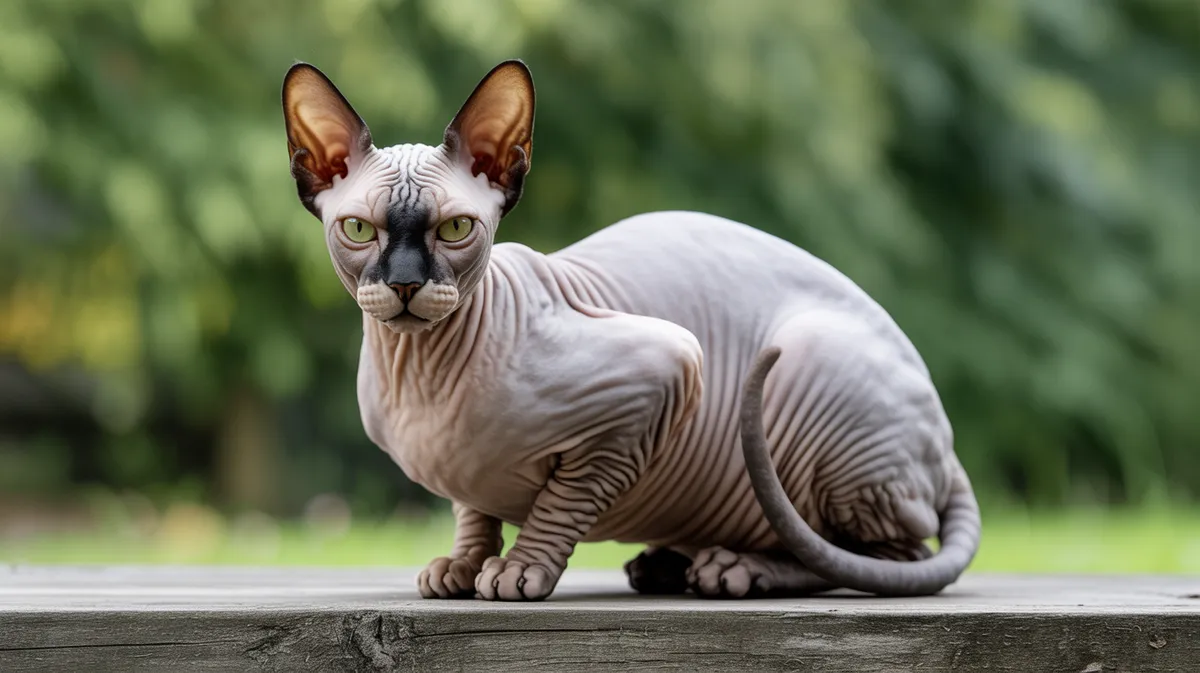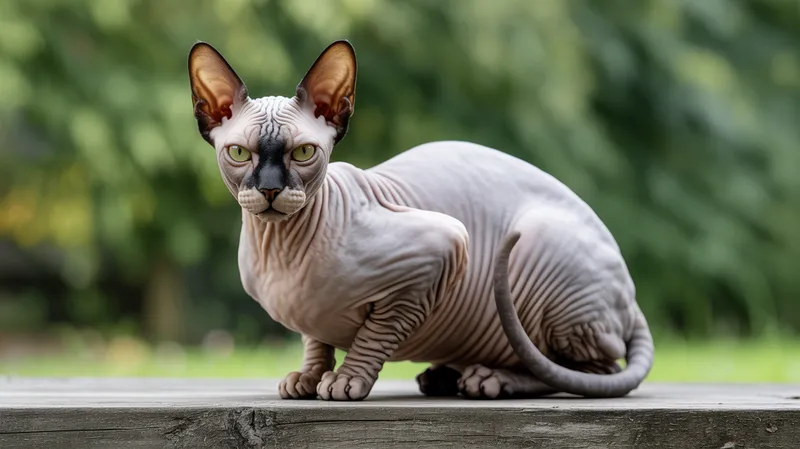
Sphynx Cat
Felis catus

Meet the Sphynx Cat
The Sphynx cat is a distinctive breed of domestic cat known for its lack of a traditional fur coat, giving it a hairless appearance. Despite their bare skin, Sphynx cats are warm to the touch and often seek warmth from their surroundings or human companions. They are highly social, energetic, and affectionate, often forming strong bonds with their owners. Their unique look is the result of a natural genetic mutation, and they require regular skin care due to the absence of fur to absorb oils. Sphynx cats are known for their playful, mischievous personalities and their tendency to greet visitors with curiosity.
Classification
Mammal
Habitat
Domestic
Diet
Carnivore
Lifespan
8-14 years
Conservation
Least Concern
Weight
3.5–7 kg
📖Fascinating Facts
Skin Care
Sphynx cats need regular bathing since their skin produces oils that would normally be absorbed by fur.
Heat Seekers
They are known for seeking out warm spots, such as sunbeams, blankets, or laps, to maintain their body temperature.
Social Butterflies
Sphynx cats are extremely friendly, playful, and thrive on human interaction, making them excellent companions.
📋Detailed Description
The Sphynx cat (Felis catus) is a medium-sized, muscular domestic cat breed distinguished by its near-total lack of fur, a result of a recessive mutation in the keratin 71 gene (KRT71). Despite their hairless appearance, Sphynx cats often display a fine layer of peach-fuzz-like down, and their skin exhibits visible wrinkling, especially around the head, neck, and shoulders. Adults typically weigh between 3.5 and 7 kg (8–15 lbs), with a robust, barrel-chested body, prominent cheekbones, and large, lemon-shaped eyes. Their ears are oversized and open, contributing to their unique, alert expression. Sphynx cats are highly active and display pronounced curiosity, often engaging in acrobatic play and interactive behaviors. They are known for their strong social bonds with humans and other pets, frequently seeking physical contact and warmth. The breed is vocal and communicative, using a range of meows, chirps, and purrs to interact. Their metabolism is slightly higher than that of furred cats, likely an adaptation to compensate for heat loss through their exposed skin. Due to the absence of fur, Sphynx cats require regular bathing to remove skin oils and are susceptible to sunburn and temperature extremes. Their lifespan typically ranges from 9 to 15 years, with some individuals reaching 20 years under optimal care.
💡 Did you know?
Despite their exotic appearance, Sphynx cats actually originated from a natural genetic mutation in Canada in the 1960s.
🔬Research & Sources
🎭Behavior & Social Structure
Sphynx cats are highly sociable and thrive on companionship, often following their owners from room to room and seeking laps or warm places to rest. They display a playful, mischievous nature, enjoying interactive toys, climbing, and puzzle feeders. Unlike many domestic cats, Sphynx cats are less likely to be aloof and are known for greeting strangers with curiosity rather than caution. They exhibit strong affiliative behaviors, such as mutual grooming (allogrooming) with other cats and even dogs. Their feeding behavior is typical of obligate carnivores, preferring high-protein diets and often displaying a hearty appetite due to their elevated metabolic rate. Sphynx cats are crepuscular, being most active at dawn and dusk, but adapt readily to their household's routine. They are also known for their tendency to burrow under blankets or clothing for warmth, and may sleep in close contact with humans or other animals.
👶Reproduction & Life Cycle
Sphynx cats reach sexual maturity at around 5 to 9 months of age. Breeding is typically managed by registered breeders to avoid genetic health issues. The estrous cycle in females lasts 14–21 days, with polyestrous cycles throughout the year if not bred. Mating behavior includes vocalizations, rolling, and increased affection. Gestation lasts approximately 63–68 days, after which litters of 3–6 kittens are born. Kittens are born hairless and require careful temperature regulation and monitoring for skin health. Parental care is provided primarily by the mother, who nurses and grooms the kittens, though human intervention is often necessary to maintain warmth and hygiene. Weaning begins at 4–5 weeks, with full independence achieved by 10–12 weeks. Responsible breeders screen for hereditary conditions such as hypertrophic cardiomyopathy (HCM) and ensure genetic diversity.
🛡️Adaptations & Survival
The Sphynx cat's most notable adaptation is its near-hairless skin, which is the result of a spontaneous genetic mutation affecting the KRT71 gene. This adaptation, while striking, is not naturally advantageous in the wild but has been perpetuated through selective breeding. The lack of fur increases heat loss, so Sphynx cats have developed a higher basal metabolic rate to maintain body temperature. Their skin is thicker and more elastic than that of furred cats, with prominent wrinkling that may aid in thermoregulation. Behavioral adaptations include a strong drive to seek warmth and close social contact, both with humans and other animals. Their large ears enhance auditory acuity, compensating for potential vulnerability due to lack of camouflage. Sphynx cats also exhibit increased grooming behaviors to manage skin oils and maintain hygiene.
📚Research Sources
🎨Cultural Significance
The Sphynx cat has gained significant popularity in contemporary culture due to its distinctive appearance and affectionate temperament. It is often featured in media, advertising, and art as a symbol of uniqueness and elegance. The breed's name references the ancient Egyptian Sphinx, though it has no direct historical connection to Egypt. In popular culture, Sphynx cats have appeared in films, television, and internet memes, sometimes associated with eccentric or mysterious characters (e.g., Mr. Bigglesworth in the 'Austin Powers' films). The breed is also celebrated in cat shows and has a dedicated following among enthusiasts. There are no known traditional uses or mythological associations predating the breed's development in the late 20th century.
🔬Recent Research & Discoveries
Recent genetic studies have identified the KRT71 gene mutation as the cause of the Sphynx cat's hairlessness, with ongoing research into the implications for skin health and immune function. Veterinary research has focused on the prevalence and management of hypertrophic cardiomyopathy (HCM) in the breed, with recommendations for regular cardiac screening. Studies on thermoregulation have highlighted the breed's increased caloric needs and behavioral adaptations for maintaining body temperature. Ongoing research also explores the microbiome of Sphynx cat skin, which differs from that of furred cats and may influence susceptibility to dermatological conditions. Advances in feline genetics continue to inform breeding practices aimed at reducing inherited health problems.
🎥Wildlife Videos

Sphynx Cats : Unveiling the Sphynx Cat's Beauty!
Embark on an extraordinary journey into the rare and captivating world of Sphynx cats with our newest video, 'Sphynx Cats: ...
Animal Tales

Sphynx Cat First Reaction To Nature Sphynx Atena
Watch the playlist with the others kittens reaction ▻https://youtube.com/playlist?list=PL6hmfs4OVph03m9KMSJjR0pLuuCwlULfC ...
Royal Animals 👑

The Quarantine Nature Documentary - EPISODES 1-5
Originally posted to tiktok @IndoorOutdoorKat.
IndoorOutdoorKat

Sphynx Cat First Reaction To Nature Sphynx Baldur
Watch the playlist with the others kittens reaction ▻https://youtube.com/playlist?list=PL6hmfs4OVph03m9KMSJjR0pLuuCwlULfC ...
Royal Animals 👑

The Quarantine Nature Documentary - EPISODES 6-10
Check out TikTok @IndoorOutdoorKat for Season 2 (and a whole new cast!!)
IndoorOutdoorKat
🌍Habitat Information
The Sphynx Cat typically inhabits Domestic environments. Sphynx Cats have adapted to their environments with specialized features and behaviors.
Primary Habitat:
Domestic
More detailed habitat information will be available soon.
🛡️Conservation Status
The Sphynx Cat is currently classified as Least Concern. Conservation efforts are crucial for preserving this species for future generations.
Common Threats:
- 🏠Habitat loss and fragmentation
- 🌡️Climate change impacts
- 🎯Hunting and poaching
- 🏭Human-wildlife conflict
⚠️Threats & Conservation Challenges
As a domestic breed, Sphynx cats are not threatened in the wild and are classified as 'Least Concern.' However, they face unique health challenges due to their genetics and physiology. The lack of fur makes them prone to skin problems, such as fungal infections, acne, and sunburn. They are also at increased risk for hypertrophic cardiomyopathy (HCM), a genetic heart disease prevalent in the breed. Temperature regulation is a constant challenge, requiring owners to provide warm environments and protection from sun exposure. Overbreeding and limited genetic diversity can exacerbate hereditary health issues. Ethical breeding practices and regular veterinary care are essential to maintain the breed's health. There is no evidence of significant population decline, but responsible breeding is crucial to avoid welfare concerns.
🔬Scientific Classification
Scientific Name
Felis catus
Classification Hierarchy
🔍 About Taxonomic Classification
Taxonomic classification is a hierarchical system used by scientists to classify and organize living organisms based on shared characteristics and evolutionary relationships.
The system moves from broad categories (Kingdom) to increasingly specific ones, with each animal's scientific name typically consisting of its Genus and species.
📝Community Notes
Share your observations and insights about the Sphynx Cat with our community of wildlife enthusiasts.
Join Our Community
Sign in to share your observations and connect with fellow wildlife enthusiasts.
Sign In to ContributeNo community notes yet
Be the first to share your observations about the Sphynx Cat!
Explore Sphynx Cat
Select a tab above to learn more about this amazing animal.
📸Photo Gallery
No photos available for this animal yet.
🌟Discover More Wildlife
Continue your journey of discovery with more fascinating animals from our database
